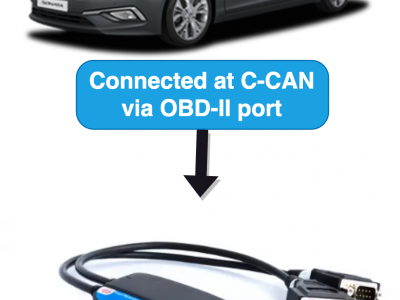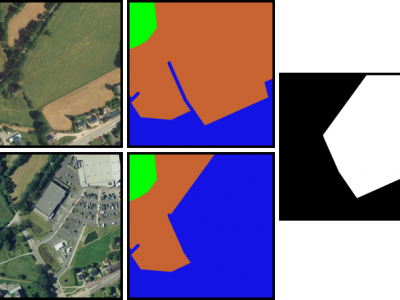Machine Learning
X-CANIDS Dataset (In-Vehicle Signal Dataset)
In March 2024, one of our recent research "X-CANIDS: Signal-Aware Explainable Intrusion Detection System for Controller Area Network-Based In-Vehicle Network" was published in IEEE Transactions on Vehicular Technology. Here we publish the dataset used in the article. We hope our dataset facilitates further research using deserialized signals as well as raw CAN messages.
Real-world data collection. Our benign driving dataset is unique in that it has been collected from real-world environments.
- Categories:
 2495 Views
2495 Views
Inertial sensors are widely used in a variety of applications. A common task is orientation estimation. To tackle such a task, attitude and heading reference system algorithms are applied. Relying on the gyroscope readings, the accelerometer measurements are used to update the attitude angles, and magnetometer measurements are utilized to update the heading angle. In indoor environments, magnetometers suffer from interference that degrades their performance.
- Categories:
 61 Views
61 Views
This dataset comprises audio recordings of ultra-high-frequency ambient noise stored in the lossless waveform format (WAW). The recordings were sampled at a frequency sample rate of 2.048 MHz and then provided at a downsampled audio rate of 48 kHz for compatibility and practical usage. The total length of the dataset is 01:30:29, consisting of approximately 260 million data points. (2024-03-30)
- Categories:
 44 Views
44 Views
Plasma-based semiconductor processing is highly sensitive, thus even minor changes in the procedure can have serious consequences. The monitoring and classification of these equipment anomalies can be performed using fault detection and classification (FDC). However, class imbalance in semiconductor process data poses a significant obstacle to the introduction of FDC into semiconductor equipment. Overfitting can occur in machine learning due to the diversity and imbalance of datasets for normal and abnormal.
- Categories:
 188 Views
188 ViewsIn our ever-expanding world of advanced satellite and communications systems, there's a growing challenge for passive radiometer sensors used in the Earth observation like 5G. These passive sensors are challenged by risks from radio frequency interference (RFI) caused by anthropogenic signals. To address this, we urgently need effective methods to quantify the impacts of 5G on Earth observing radiometers. Unfortunately, the lack of substantial datasets in the radio frequency (RF) domain, especially for active/passive coexistence, hinders progress.
- Categories:
 589 Views
589 ViewsAnomaly detection plays a crucial role in various domains, including but not limited to cybersecurity, space science, finance, and healthcare. However, the lack of standardized benchmark datasets hinders the comparative evaluation of anomaly detection algorithms. In this work, we address this gap by presenting a curated collection of preprocessed datasets for spacecraft anomalies sourced from multiple sources. These datasets cover a diverse range of anomalies and real-world scenarios for the spacecrafts.
- Categories:
 835 Views
835 ViewsTo access this dataset without purchasing an IEEE Dataport subscription, please visit: https://zenodo.org/doi/10.5281/zenodo.11711229
Please cite the following paper when using this dataset:
- Categories:
 1039 Views
1039 Views
This data is the reanalysis of sea surface temperature provided by Extended Reconstruction Sea Surface Temperature version 5 (ERSST v.5) from January 1854 to December 2022, Hadley Centre Global Sea Ice and Sea Surface Temperature (HadISST) from January 1870 to December 2022, and COBE-SST2 Sea Surface Temperature and Ice (COBE-SST2) from January 1854 to December 2022. All data is re-gridded to have the same spatial resolution of 2.0° × 2.0°, and the grid spans from 88°N to 88°S and 0°E to 358°E via bilinear interpolation from the initial grid. This dataset is in NetCDF4 format.
- Categories:
 118 Views
118 Views
Image representation of Malware-benign dataset. The Dataset were compiled from various sources malware repositories: The Malware-Repo, TheZoo,Malware Bazar, Malware Database, TekDefense. Meanwhile benign samples were sourced from system application of Microsoft 10 and 11, as well as open source software repository such as Sourceforge, PortableFreeware, CNET, FileForum. The samples were validated by scanning them using Virustotal Malware scanning services. The Samples were pre-processed by transforming the malware binary into grayscale images following rules from Nataraj (2011).
- Categories:
 525 Views
525 ViewsThis data was recorded for emg based force/Torque estimation. EMG and torque signals were collected during simultaneous, isometric, but continuously varying contractions, corresponding to two wrist DoF. The experiment was carried out in two trials with a 5-min rest in between. Each trial included six combinations of tasks, separated by 2 min of rest to minimize the effect of fatigue. The performed tasks were categorized into individual and combined (simultaneous) DoF to test the ability to estimate isolated torque and torque in two simultaneous DoF.
- Categories:
 290 Views
290 Views



